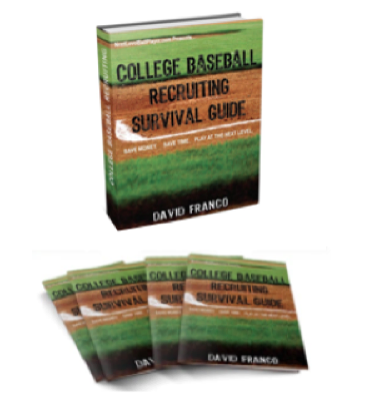Part two in a series by Jeff Opalewski about college baseball and the recruiting process. (Read part one here.)

Academics are far more important to the recruiting process than most realize. The most obvious connection between academics and recruiting is in the initial eligibility requirements and registering with the NCAA Eligibility Center. The reality is that this is merely the first issue involving academics and it is a multi-layered issue. Other issues to be considered are maintaining eligibility, graduating, and academic scholarships.
Meeting NCAA Eligibility Requirements
As previously mentioned the obvious connection between academics and recruiting lies in the initial eligibility requirements laid out by the NCAA that each student-athlete must meet in order to be eligible to compete or receive an athletic scholarship their first year at an NCAA member institution. From our point of view, if a player is not going to be an initial qualifier then we cannot spend time recruiting him – he should go to a junior college for 2 years and hopefully can become eligible to transfer in as a junior. It is fairly simple. The more difficult decisions revolve around the players that are below average students but do meet the NCAA’s initial eligibility requirements. We must consider why this student is below average and how great the risk is that the player does not remain eligible for his entire collegiate career and ultimately graduate. If we are comfortable with our academic support services, the young man’s discipline to develop good study habits, and his ability to utilize the assets available to him to maintain eligibility and then graduate, we likely will continue recruiting that player. These academic risks take more time not only from our academic support staff, but also from our coaching staff in that we have to monitor study table hours and tutor attendance. Realistically, it takes a player that we feel is a difference maker in order to justify the additional time we would need to spend on academics with him, given that there is only so much time in a given day, and every minute we spend worrying about academics takes away from the time we are able to spend coaching, organizing, and preparing for baseball related activities. As you can imagine, when have to spend too much time as a coaching staff on academics another area begins to suffer and it hinders our ability to develop the players in our program and prepare for games – which can ultimately lead to losing games. And of course when a player is ineligible to play, he cannot help you win.
Academic Progress Rate
Another factor that is consistent with the previous issue I mentioned is the Academic Progress Rate (APR) that the NCAA has established that takes into account player eligibility, retention rate, and graduation rate to ensure that each program is operating consistently with the mission of the NCAA. In the simplest terms possible, each player is worth 4 points each year, and loses a point if he becomes ineligible, leaves the program, or does not graduate within 5 years of the beginning of his collegiate career. If any of those things happen too often, penalties will occur where a program can lose scholarships and sometimes lead to a head coach getting fired.
Academic Scholarships
On the other side of the academic spectrum is the opportunity for a player to earn an academic scholarship that can allow the 11.7 scholarships each Division I baseball program are allotted to stretch further. Based on the 11.7 scholarships we are allotted and being able to split it between 27 players, the average scholarship each player receives is 43%. Anything that can be done to raise that number without impacting our scholarship limit is very beneficial as we strive to put the best team on the field each year. It stands to reason that in most cases the best players are the most heavily recruited and command the largest scholarships. Every school has their own criteria for academic scholarships, but any academic scholarship at an institution a player qualifies for who has either a 3.5+ cumulative GPA, graduates in the top 10% of his high school class or scores a 105+ composite ACT score does not count against the programs 11.7 scholarships and enables the program to give a baseball scholarship on top of the academic money. It becomes much more realistic for players to receive large scholarships when there is a combination of athletic and academic aid involved.
Student-Athletes not Athlete-Students
When considering the information previously laid out, it is every programs desire to recruit the highest caliber student-athletes possible. Of course we cannot sacrifice the caliber of player we recruit in favor of great students, but when there are comparable players the offer is going to go to the better student in most cases. Any time I am out recruiting and have academic information available, the first thing I do is highlight all of the players that meet the academic scholarship exemption criteria knowing these are the players that I need to be sure I get a very thorough evaluation on because they are the most desirable to recruit. Colleges and Universities are educational institutions first, and all athletic programs must operate within the guidelines set forth not only by the NCAA, but also the institution they work for. Any player that is recruited to play a collegiate sport is afforded a multitude of benefits and opportunities, but easily the greatest of these is the opportunity to earn a degree.
——
If you are looking for more information on college baseball recruiting, check out this 42-page guide designed to help players and parents alike as they navigate through the recruiting process and help you take initiative in your own recruiting process. If you are a high school baseball player (or parent) who is not sure how the recruiting process works, then the College Baseball Recruiting Survival Guide is a must have. Click here to learn more.

Leave a Reply